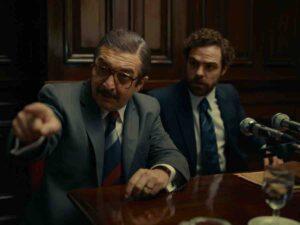Argentina, 1985, a Spanish courtroom drama directed by Santiago Mitre, depicts the country’s historic Trial of the Juntas, the first-ever conviction of a military dictatorship by a civilian judicial system. The 140-minute-long film narrates the gruesome tale of bureaucracy and moral corruption by examining the famous case from the viewpoint of its chief prosecutor, Julio César Strassera (Ricardo Darin). The plot revolves around the heroic efforts of a group of non-lawyers, aged 20 to 27, led by prosecutors Julio and Luis Moreno Ocampo (Peter Lanzani), against those in charge of the bloodiest dictatorship in Argentina’s history, which tried the perpetrators of the country’s last civil-military dictatorship (1976–1983).
The trial is testimony to how misuse of political power often leads to the downfall of an authoritarian regime. Based on real incidents, the screenplay by Mitre and Mariano Llinás is more of a detailed examination of certain key incidents that defy the tropes of a thriller. The subject will resonate with even those with no direct knowledge of the effects of the juntas’ so-called “dirty war” against alleged seditionists and infiltrators. The film is designed as a brazen exposé of the dark world of politics, where mayhem and death are planned for personal advantage and the truth is forsaken on the altar of suspicion and sadistic pleasures. It is a thought-provoking and informative portrayal of what it takes to hold tyrants accountable within the framework of a judicial system. The perseverance, documentation, and courage required to obtain justice for citizens of a country who have been subjected to physical and mental torture is comparable to winning a war against an oppressive system.
Argentina, 1985, uses title cards as a device to inform viewers of the atrocities carried out by the right-wing military junta that seized power from 1976 to 1983. It was involved in the killing and kidnapping of approximately 30,000 civilians thought to be opponents. As the story proceeds, it is revealed that the nine authoritarian leaders who are accused of war crimes insist on going to trial before a military tribunal, which inevitably treats them leniently. These elderly officers are the adversaries in uniform who enter and exit the courtroom without a trace of regret for their heinous acts.
So, from the beginning of the film, we are introduced to how the defeated military continues to exert excessive power within the newly elected government bodies. As Julio prepares for the trial, he receives threats in various forms and often gets caught up in the whirlpool of paranoia. He further believes that the newly elected leadership is using him, and worries for his family’s safety. Even his colleague, Luis, who comes from a prominent military family, can not escape the consequences of his decision. All of this is to emphasize how mentally grueling it was for the prosecutors to deliver justice.
When the trials began, we’re informed about the junta’s several gut-wrenching barbarous acts. A young woman reflects on her experience of being forced to give birth while chained and blinded while being held captive by the junta in the film’s most traumatic moment. Such terrifying testimonies, along with the strong argumentative confrontations, provide the film with intensely emotional and tense moments. The filmmaker leaves it to the victims to describe what the regime did to them through their charred emotional wounds.
It is rare to come across courtroom dramas that tackle contentious and brutal subjects, relying entirely on subtle, subdued details. Ricardo Darin and Peter Lanzani excel in their respective roles. They seamlessly embody their respective characters, never drawing our focus away from the narrative. The trial, in which Strasser presents 709 examples, is the focal point of the film. Darin’s low-key act in his eight-minute-long closing monologue is a knockout. Even in the portrayal of the Strassera family, there is authenticity. Santiago Armas Estevarena as Javier, Gina Mastronicola as Veronica, and Alejandra Flechner as Silvia make their scenes feel informed and real, rather than forced. Each of them is crafted with a personality. There are tiny yet significant events that cement the genuineness of their relationships with one another. When the unavoidable death threats start, it anchors us in their reality and causes us to become concerned.
Javier Julia’s cinematography transports us to Argentina in 1985, especially the tense scenes in the cramped courtroom or the discussions taking place in Julio’s office. The claustrophobic environment surrounding the characters seems palpable. It is one of those rare films that hits the right emotional chord without resorting to gimmicks or dramatic foreshadowing. He frames the busyness of Buenos Aires in such a way that the towering government buildings, where the most of the action takes place, appear like a dominating figure. The story also benefits from production designer Micaela Saiegh’s understated period accuracy.
After the Golden Globes win, Argentina, 1985 has a fair chance at the Oscars. It’s a compelling work of cinematic documentation with many objectionable similarities to contemporary abuses of power and cruelty.
Where to Watch: Amazon Prime
